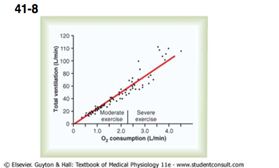Breathing and Exchange of Gases - Online Test
Read the following statements :
i. Pressure contributed by and individual gas in a mixture of gases is called its partial pressure
ii. in alveolar air is 45 mm Hg and in venous blood is 40 mm Hg.
- In a mixture of gases, each gas has a partial pressure which is the hypothetical pressure of that gas if it alone occupied the entire volume of the original mixture at the same temperature. The total pressure of an ideal gas mixture is the sum of the partial pressures of each individual gas in the mixture.
- The in alveolar air is 40 mm Hg and in venous blood is 45 mm Hg.
Read the following statements :
i. The affinity of Hb for CO is 200 to 250 times more than its affinity for oxygen therefore CO competes with oxygen for binding to Hb.
ii. The result of this binding are a shift of oxygen-hemoglobin dissociation curve to the left and its alteration to a more hyperbolic shape.
RBCs and muscle cells carry out anaerobic respiration, but :
i. RBCs are permanently anaerobic and muscle cells are temporarily anaerobic
ii. RBCs are temporarily anaerobic and muscle cells are permanently anaerobic
iii. Muscle cells lack mitochondria.
Water breathing is more problematic than air breathing because :
i. water is 800 times more dense and hence holds much more oxygen than air does.
ii. since oxygen dissolved in water diffuses far more slowly than air therefore large quantity of water is required to be passed over the gills.
i. Hemoglobin is the pigment present in our blood and is iron containing protein.
ii. Haemocyanin is the pigment present in blood of Palaemon and is copper containing protein.
iii. Haemocyanin is much more efficient than haemoglobin.
The given graph shows consumption and ventilation during exercise so we can infer from this graph :
i. During exercise, oxygen consumption rate in our body increases.
ii. Neural stimulus allows abdominal muscles , which are a kind of smooth muscle to contract to facilitate ventilation while exercising.
iii. Increase in ventilation during exercise prevents large changes in the partial pressure of or
iv. The overall impact is breathing rate increases.
i. the alveoli that lowers the of blood and raises its is external respiration
ii. the tissues that lowers the of blood and raises its is internal respiration
